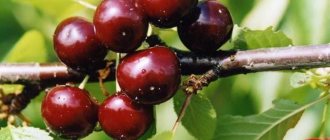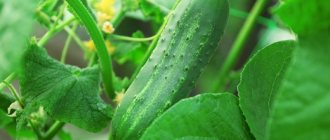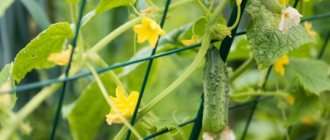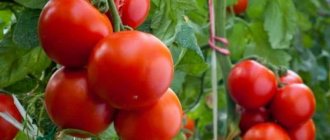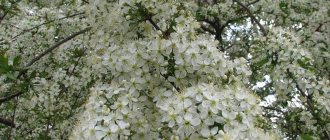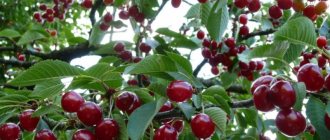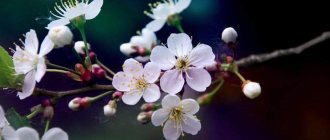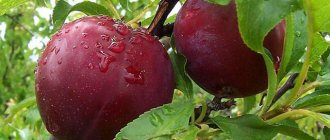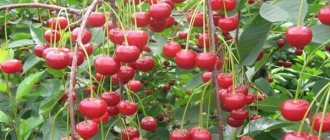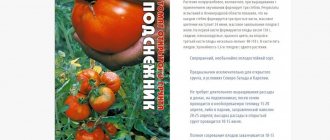Description of the Shpanka cherry variety
Shpanka belongs to the so-called folk varieties, the authors and exact date of origin of which are unknown. It was isolated in the 19th or early 20th centuries (or, according to other sources, more than 200 years ago) as a result of crossing sweet cherries and cherries, so from a scientific point of view it is a hybrid that has become a separate stable variety. Over many decades, Shpanka has proven itself well and has spread widely throughout the territories of Russia, Ukraine and Moldova.
The origin of the Shpanka cherry is difficult to establish, which is why it is called a “folk” variety
The height of the tree reaches 6 m, but there are specimens up to 10 m high. The lifespan of the plant is 20–25 years. In some cases, with proper anti-aging pruning, up to 30 years or even more, but that’s not all. When the cherry begins to age, one root shoot is left under it. Then the withered old trunk is cut down, and a new tree remains as it approaches fruiting. Thus, without any problems, it is possible to keep cherry plantings in one place for many decades. In the Central Black Earth Region and other regions there are still old plantings of cherries that have been growing since the late 40s - early 50s of the last century.
With proper pruning and proper care, the lifespan of a cherry tree can be extended for decades.
The trunk and perennial branches of Shpanka are dark brown, young ones are much lighter. This is important to know, because cherries bear fruit exclusively on young shoots, which is taken into account when pruning. The foliage of the crown is average. Therefore, Shpanka is not prone to thickening and shades itself little within the crown even without thinning pruning. The branches do not grow upward, as in pyramidal varieties, but at right angles to the trunk, parallel to the ground. This can be considered a disadvantage, because under the weight of a large harvest they can sometimes break and require the installation of supports. Shpanka's leaf is long, 7–8 cm, more like a cherry leaf, the petioles are pink.
Shpanka produces its first small harvest 5 years after planting a 1.5–2-year-old seedling. Then, over the years, the yield increases, reaching its peak at 15–18 years. At this age, one tree can produce 50–60 kg of berries. The average yield at other life stages is considered to be 35–40 kg. The berry is flattened, weighing up to 5–6 g, which is considered large for a cherry, dark burgundy in color when ripe, juicy. The flesh inside is yellow, the stone comes off easily. The berries are sweet, juicy, with a slight sourness.
In terms of taste and quality of berries, Shpanka has very good indicators among cherries precisely because it inherited part of its ancestor - the sweet cherry. However, the fruits do not last long and require quick processing or freezing.
The harvest ripens by mid-summer. Fruiting is gradual, extending almost until the end of summer. Ripe fruits fall off on their own at the slightest breath of wind, so they must be collected on time.
Shpanka is considered self-fertile, that is, it does not require cross-pollination with neighboring cherries - both male and female flowers grow on the same tree. A single tree will also bear fruit. But the harvest is more abundant and the quality of the fruit is higher if Shpanka grows in a group of cherries of any other varieties.
To prevent the garden from being diverse, it is not recommended to plant low-growing or dwarf varieties next to the tall Shpanka, which will also be heavily shaded.
An adult Shpanka tree produces up to 40 kg of cherries
Shpanka is a hardy variety that can withstand drought and severe frosts in winter (down to -35°C). But the properties of the heat-loving ancestor (cherry) do not allow the variety to spread far to the north. Cherries can survive winter, but too short a summer will not allow the fruits to ripen. However, Shpanka is growing in the Moscow region and the Middle Volga region.
How to harvest and store it?
You can’t delay collecting Shpanka. The cherry quickly rots right on the tree and falls off. Since fruiting is not widespread, it is advisable to collect reddening berries daily or at least once every 2-3 days.
The optimal time for harvesting is not too early in the morning (from 8:00 to 10:00). At this time the dew is already drying. Be sure to remove the berries along with the stalks and never harvest cherries in the rain. Otherwise, the already short shelf life of the berries will be further reduced to a day and a half.
The berries are removed exclusively by hand, tearing off the stalk or cutting it with scissors. Do not squeeze the cherries too hard, do not damage the skin with your nails, place the fruits in containers carefully, and do not throw them away. Only cherries without the slightest signs of damage by diseases and pests are selected for storage. There is no need to pre-wash them.
The Shpanka harvest is a worthy reward for the gardener’s efforts
Shpanka can be stored in the refrigerator in plastic bags for no more than 4–6 days. Cherry easily absorbs odors, so seal it tightly. You can extend this period by about half if you place the berries in sterilized jars, layer them with cherry leaves and roll up the lids. This container is also stored in the refrigerator.
It will not work to cheat and pick cherries that are slightly unripe, thereby extending the shelf life. The berries will no longer be sweeter than they are. Therefore, those who want to preserve Shpanka for a long time can only dry, freeze, dry the berries or do home canning. The variety is absolutely universal and is suitable for making compotes, jams, preserves, jellies, marmalade, and so on.
Cherry jam in the middle of winter evokes memories of summer
Cherry propagation
Shpanka is successfully propagated by root shoots. Removing suckers under the trunk is a mandatory maintenance operation because they deplete the main tree. And if the shoots are not touched, then in a few years they will become a competitor to the main trunks and each other, causing thickening, and as a result, instead of a garden there will be an abandoned impenetrable jungle with a small harvest.
The shoots are cut to the ground level, leaving no stump, then thrown away or burned. But you can use it as planting material. To do this, select a suitable seedling from what has grown at the moment or, cutting out the shoots, leave a few of the strongest shoots in order to replant them in a year or two. It is optimal to replant 1.5–2 year old shoots with a height of 60–80 cm.
The seedling selected for transplantation is dug up to the depth of a spade bayonet around the perimeter and pulled out along with the soil, trying to keep as many roots intact as possible. In the process of removing the seedling, a horizontal thick uterine root will be revealed, coming from the main tree. It is cut off with a shovel or cut with pruning shears. When digging up shoots, one must not forget that the work is being done in the area of the root system of a living tree, so there is no need to dig too much. The hole is then filled with loose soil and sprinkled with fallen leaves or mulch. The seedling is placed on damp burlap and the entire root system is covered with it.
Correctly cut root shoots are removed along with the roots and a lump of earth
But if you manage to find a 2.5-3 year old shoot that already looks like an independent seedling, you can replant it, this will speed up the first harvest by 1-2 years. In an abandoned garden you can also find a 4-5 year old seedling. But the older it is, the worse it takes root, and the larger the volume of roots and soil will have to be moved along with it.
It can also be propagated by grafting onto the rootstock of outbred but hardy cherries. But this is more difficult and time-consuming, because first you need to grow the rootstock, then wait for the grafted shoot to grow back.
Features of care
Caring for Shpanka - fertilizing, pruning, pest and disease control - is almost standard, as for all tall cherries. Some features:
- Shpanka are planted no closer than 3 m from each other. If space allows, you can increase the distance to 3.5–4 m between rows. This is a tall tree with a very branched root system in area - 2–2.5 times wider than the crown area.
- During the growth process, like all ancient varieties, Shpanka practically does not require fertilizing, especially on chernozems and other fertile soils. But proper fertilizing with organic matter or modern fertilizers, especially on poor soils, can be beneficial.
- The variety is resistant to fungal diseases, coccomycosis and monolithic blight, which simplifies care.
- The tree may require watering if there is no rain during flowering and ovary formation.
- In abnormally cold frosts, it is important that the ground under the tree is covered with a thick layer of snow. If there is no snow, you will have to cover the soil with a layer of mulch made from sawdust, humus, leaves, hay, straw, manure, compost or peat with a layer of about 10 cm. The main thing is that the roots do not freeze.
- If some of the branches freeze in winter, they are cut off in the spring.
Many years of experience in growing Spanka have shown that almost the only problem in its cultivation is harvesting from a tall tree.
Recent Entries
5 working ways to use tar in the garden 7 indoor plants that help you get married even in adulthood Indoor plants that can bloom in trouble
Disease and pest control
Healthy Shpanka cherries have good resistance to fungal diseases and harmful insects. If the tree grows on poor, heavy soils or in areas where groundwater comes very close to the surface, problems cannot be avoided.
Cherry diseases and pests - table
| Diseases and pests | Symptoms | Control measures | Prevention |
| Monilial burn | The disease is caused by a fungus that attacks leaves, shoots and ovaries. Young branches dry out quickly. Cool and damp weather contributes to the spread of the disease. |
|
|
| Sooty fungus | The leaf blade becomes covered with gray spots, which merge and form a black, soot-like coating. Biochemical processes in the leaves stop. | Spraying is carried out with a solution of copper oxychloride (40 g per 10 liters of water), Bordeaux mixture or a copper-soap mixture (5 g of copper sulfate and 150 g of soap per 10 liters of water). |
|
| Gum formation or gommosis | Appears after a burn, frostbite, or excessive use of fertilizers. Bacteria settle in the resin-impregnated bark, which causes the branches to wither. | Resin growths are removed down to healthy tissue. The wounds are treated with a 1% solution of copper sulfate, after which they are covered with garden pitch. |
|
| Cherry slimy sawfly | They gnaw out the pulp of the leaf, leaving only a network of veins. | The cherry harvest field is treated with Iskra, Aktara or Inta-Vir. The solution is prepared according to the instructions. | In the fall, be sure to dig up the soil in the tree trunk circle and between the rows. |
| Cherry weevil | Actively feeds on buds, buds, and ovaries. From the eggs laid in the seed, a larva emerges and gnaws at the fruit. |
|
|
Photo gallery: Cherry diseases and pests
Entire branches die from monilial burn
Sooty fungus on leaves
Gum application can greatly weaken cherries.
The cherry sawfly severely damages foliage
If you don't fight the cherry weevil, you may be left without a harvest.
Varieties of Shpanka variety
At the end of the 20th - beginning of the 21st century, based on the ancient Shpanka variety, breeders created new varieties that are also worthy of the attention of gardeners.
Shpanka Bryansk
The variety was included in the State Register in 2009 and is recommended for use in the Central region. The trunk is short, of medium height, that is, lower than the old Shpanka. The shoots do not grow parallel to the ground, but upward, which is why the tree has a different shape. The color of the bark is gray-olive. The fruits are smaller, weighing up to 4 g, round-flat, light red. Sugars reach up to 9%, which is far from a record, so the taste of ripe fruits is not sweet and sour, but, on the contrary, sweet and sour. It is considered self-fertile, capable of bearing fruit on a single tree. Early ripening.
The average yield of Shpanka Bryanskaya, according to the State Register, is 73 centners per 1 hectare, that is, 73 kg per 100 m2, or about 8 kg per trunk. According to other sources, Shpanka Bryanskaya yields about 35–40 kg from one trunk, which is closer to reality.
Shpanka Bryansk cherry is recommended for cultivation in the Central region
Shpanka Shimskaya
The variety was named after its place of origin - Shimsky district of the Leningrad region. Therefore, it is perfectly adapted to the conditions of the North-West.
An early ripening variety, the berries ripen in late June - early July. Fruits until August. The further south the region, the faster fruiting begins. From one mature trunk you can collect up to 45–55 kg of fruit. It begins to bear fruit at 3–4 years of age and has a lifespan of up to 25 years. The fruits are medium-sized, up to 3.5 g, light red even when ripe, sweet and sour. The pulp is light pink, the juice is not coloring.
The tree is medium-sized, up to 3 m in height. The crown is bush-like, sparse, and does not require thinning pruning. The bark is very dark, almost black even on young two-year-old shoots. It tolerates winter well, but can sometimes suffer from a fungal disease, monilial burn, which will require treatment with fungicides.
The variety is self-sterile, and therefore requires planting in a group with pollinators, cherries of other varieties, for example, Vladimir or Korostyn.
Shpanka Donetsk
Like Shimskaya, it was named after its place of origin - Donetsk Experimental Horticulture Station. This is a hybrid of cherry and cherry. The crown in the first years is in the shape of a pyramid, then becomes rounded. The variety produces record large berries - up to 6-7 g. The fruits are light red, the flesh is yellow, the taste is sweet and sour. The variety is winter-hardy and drought-resistant. In severe frosts in winter it may suffer, but is able to recover quickly. The tendency to fungal diseases is average.
The tree begins to bear fruit at 3–4 years of age, reaching its peak at 9–12 years of age.
A variety of low self-fertility, a single tree will give a small harvest. Therefore, it requires planting in a group for mutual pollination. In warm regions, it is recommended to plant cherries rather than cherries or hybrids for pollination.
Shpanka Donetskaya has large light red berries
Dwarf spank
Dwarf Shpanka berries have an excellent taste. It is a hybrid of cherry and black cherry, so it has the taste of black cherry combined with the best flavors of cherry. The variety is considered tenacious and hardy, resistant to frosty winters, fungal diseases and pests, and therefore grows successfully in the North-West.
The average height of an adult dwarf Shpanka tree is no more than 3 m
Kursk spanka
This variety was isolated by breeding scientists almost a century ago. And in 1938, it was given a separate name, Shpanka early, or Kursk, according to its place of origin, to avoid confusion in the group of varieties, also known as Shpanka. Many people still confuse it with the large southern Shpanka. But these are two separate varieties, very different from each other. Kursk shpanka is not a hybrid with cherries, but a pure cherry, it belongs to the amorel type, that is, a red cherry with colorless juice. The variety was widespread in the Kursk region, less common in neighboring regions. It never grew in more northern areas, possibly due to its low winter hardiness. And even in the southern regions, cherries froze severely during harsh winters.
The variety is early, the fruits ripen from mid-June. The tree reaches a height of 4 m. The crown is wide and spreading, sparse, the shoots are thick, gray-brown in color. Productivity depends on the wintering conditions of flower buds. If the buds do not freeze, the tree produces up to 30 kg of fruit. It begins to bear fruit at 4–5 years. Life span is up to 25 years, peak yield occurs at 12–18 years.
Propagated by grafting onto sour local cherry seedlings. This increases its frost resistance. Although it can also be propagated by root shoots. For pollination, you need to plant it in a group with varieties of the same height - Vladimirskaya, Kentskaya and varieties of the Griot group.
Historical reference
The Shpanka variety was first mentioned 200 years ago. It combines the qualities of several plants growing in different regions. The first trees of this species appeared in the gardens of Ukraine. They appeared thanks to the natural cross-pollination of cherries and sweet cherries.
Sprouts began to gain popularity in the southern regions. In a short time, the variety began to be cultivated in Moldova and the Krasnodar Territory. Currently, trees can be found in regions with harsh climates: in the Moscow region, Siberia, and the Urals. Such relocation became possible thanks to the improvement of the hybrid. He acquired frost resistance and endurance.
Reviews
I have the “Early Shpanka” variety, zoned for all regions of Ukraine. I buy tree seedlings from the Zaporozhye nursery and there are no special problems. I won’t give any advice for the North-East of Ukraine and other regions, but I will advise you to take zoned seedlings from nurseries in your region.
Slavuta_M
https://chudo-ogorod.ru/forum/viewtopic.php?f=47&t=1713&sid=c70a41b03fb83a2e0ca2f2c2f4a95f43&start=10
I grow an old variety of cherry - Shpanka, which does not suffer from anything. At all. The sweet, juicy dark berry ripens earlier than Vladimirskaya. I cut my cherries with a scythe - it’s an ancient garden. I gave the seedling to my brother in the Moscow region (Istrinsky district), everything took root.
Elen Fionko
https://www.agroxxi.ru/forum/index.php/topic/184-%D0%B2%D0%B8%D1%88%D0%BD%D1%8F/
Shpanka cherry, the “pedigree” of which has not yet been traced, is a wonderful confirmation that nature is a talented breeder. This hybrid, distinguished by its wonderful taste of berries, stable yield and low maintenance requirements, has been enjoyed by gardeners for more than 200 years. Breeders do not give up attempts to “correct” nature, developing new varieties based on Shpanka.
Andrey Kamenchanin
https://forum.vinograd.info/showthread.php?t=351&page=172
Video: growing Shpanka
Old varieties, reliable and proven over centuries, can get lost among the abundance of new ones with convenient qualities - fast-growing, fast-growing, easy-to-harvest, low-growing, and so on. Therefore, there is a reason to find the “real” Shpanka in old gardens, knowing exactly what it is, and replant it, preserving it in the new garden.
- Author: Gennady Chernikov
Rate this article:
- 5
- 4
- 3
- 2
- 1
(2 votes, average: 5 out of 5)
Share with your friends!

